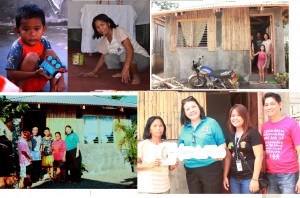
A BOY kept rolling his toy train in the newly finished floor. Another was pulling a string attached to his toy truck in his brand new house. In an adjacent abode was a woman who was busy putting wax on her floor. Just a block away, a lady gave a sigh of relief as she was done putting a colorful curtain in her window.
While the children never knew, the adults were busy in preparation for the visitors who will be looking into the shelters exactly one year after Haiyan or the locally known typhoon Yolanda lashed at their place and damaged their houses.
This was the scenario at Belle Village I in Brgy. Tacas, Pontevedra, Capiz where 14 shelter units are targeted to be constructed under the Post Yolanda Support for Safer Homes and Settlements project with the stewardship of the United Nations Habitat and in partnership with the Housing and Urban Development Coordinating Council, Government of Japan, Social Housing Finance Corporation and Department of Social Welfare and Development (DSWD).
“This is where we will eat our Media Noche on December 24,” said Liberty Diestro, one of the recipients of the housing units. Diestro received in a simple turnover ceremony her house key as it was one of the first units completed.
Tacas is only one of the many sites of the project. Presently, there are 80 units which are under construction, most of them on near completion status while more than 10 are finished. It is targeted that by March 2015, a total of 610 units would have been built.
Other areas are Ilawod and Tabuc in Pontevedra; Bato and Pawa in Panay; Baybay, Milibili, Punta Tabuc, Bato, Culajao and Tiza in Roxas City; and Poblacion, Estancia, Iloilo.
“Mabakud siya nga balay (This house is sturdy),” said Wilma Borbon as she pointed of the houses which are completed. Wilma is currently staying at a temporary shelter and awaiting the construction of her own unit at the village.
COMMUNITY DRIVEN APPROACH
The project uses a community driven approach to recovery and rehabilitation under UN’s Post Yolanda Support for Safer Homes and Settlements.
It aims to address the need of Yolanda-affected families for better and safer homes and settlements. Consultations with community groups helped UN Habitat design and refine a sturdy house meant to meet basic needs of the beneficiary households. The design was developed in collaboration with the Capiz chapter of the United Architects of the Philippines, and its structural integrity has been checked by the Capiz chapter of the Association of Structural Engineers of the Philippines.
The project is supported by the government of Japan with a $2.5 million fund and co-funding from DSWD./dswd6/May Rago-Castillo (with report from UN Habitat Philippines and UN Habitat Roxas City Office)
